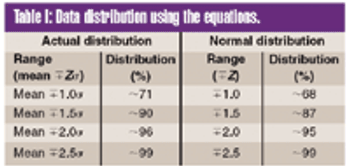
What the industry needs most is not reduced oversight. What we need is, competent, constructive, informed, consistent, fair, and predictable inspection.

What the industry needs most is not reduced oversight. What we need is, competent, constructive, informed, consistent, fair, and predictable inspection.

To meet the requirements of the USP ^755& Minimum Fill and ^698& Deliverable Volume tests, target fill levels greater than 100% must be established.This article proposes a criterion for establishing an appropriate target fill level such that a sample will have a 95% probability of passing these USP tests at 95% confidence.

The authors argue that chlorine dioxide (CD) is a safe and effective decontaminating agent that can be used for challenging applications.The effectiveness of CD gas for sterilizing complex isolator systems is studied.

Nanotechnology is believed to hold enormous promise for the future of medicine and healthcare...

A comparative study of three air samplers used for bioaerosol collection was performed to evaluate the average recovery of colony-forming units and to assess the precision of each device.

Nanostructured lipid carriers are a new type of delivery system offering improved performance in terms of drug loading and long-term stability with the ability to form highly concentrated dispersions...

X-ray microtomography has great potential for improving the understanding of the structural features of solid dosage forms and the changes in those features during manufacturing, handling, and storage. This article describes the basic principles of the technique and provides examples of its potential applications.

To meet the requirements of the USP ?755? Minimum Fill and ?698? Deliverable Volume tests, target fill levels greater than 100% must be established. This article proposes a criterion for establishing an appropriate target fill level such that a sample will have a 95% probability of passing these USP tests at 95% confidence.

In this article, the author explains some of the technology behind using ion-exchange resins for drug delivery...

This article examines the importance of core design and formulation on the quality of a film coated tablet...

Warning Letters: Alternative Health and Patient First

FDA New Drug Review Times Continue to Drop in 2004

Warning Letter: Germiphene

Warning Letter: Germiphene

USP to Publish Spanish Translation of USP-NF; Council of Experts Named

"Stable Liquid" Technology Permits Heptavalent Vaccine Against Botulism

Warning Letters: DanChem Technologies & Medsep

Nanoparticle Synthesis Process Facilitates Chiral Separations

UK MHRA Okays Chiron Flu Vaccine Plant; FDA Approval Still to Come

FDA Approves Treatment for Smallpox Vaccination Side Effects

Nanoparticle Synthesis Process Facilitates Chiral Separations

Big Pharma Companies Team Up to Develop Once-Daily, Triple-Combination HIV Drug

Some published articles purport to demonstrate the difficulties and problems of the laser diffraction technique without mentioning that these apparent problems are inherent in all particle-sizing techniques. This article discusses some of the advantages of using laser diffraction for particle sizing-including repeatability, ease of verification, and speed of measurement-and why it has become the preferred technique in a range of industries.

IPEC-Americas has just completed a major update to its significant change guideline to address current issues in the manufacture of excipient ingredients and to assist manufacturers in developing an impurity profile.

As newer and more elaborate hardware and software systems are installed in automated manufacturing environments, companies are further incorporating good practices into their validation process.